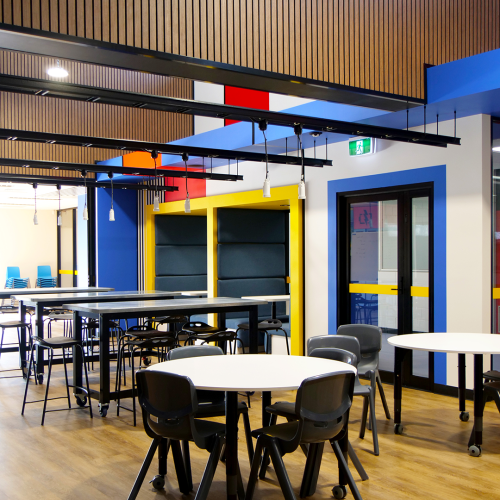The Braggs Building
- Client:
- Adelaide University
- Location:
- Adelaide, South Australia
- Features:
- 420 seat lecture theatre; research and undergraduate laboratories; workshops, teaching spaces and offices
- Awards:
-
AIA SA Jack McConnell Award for Public Architecture - 2013
AIA National Commendations for Public Architecture, 2013 - Hames Sharley & BVN Donovan Hill in association - 2013
The facility completes the newly developed science and research precinct on the North Terrace campus, housing both research, and undergraduate laboratories, and a 420 seat lecture theatre. The central philosophy of the building focused on enabling researchers from different disciplines – physics, chemistry, biology – to come together to allow a transdisciplinary approach to research fostering both formal and informal collaboration. As such, the building investigates methods of three-dimensional connection of space within the tight security and safety requirements of a leading laboratory environment, through its positioning on campus, its relationship to campus life, and its strategic inclusion of two vibrant internal vertical streets.
As part of this program, the University of Adelaide is embarking on the redevelopment of the lower level of the North Terrace campus that incorporates a new research facility. This strategic new facility will be located in the developing science and research precinct on the North Terrace campus and will house the Institute for Photonics and Advanced Sensing (IPAS). This facility will bring together physicists, chemists and biologists to pursue a new transdisciplinary approach to science.
IPAS aims to develop photonics, sensing and measurement technologies that will change the way scientific research is done within traditional areas and will serve to stimulate the creation of new industries and inspire a new generation of scientists engaged in solving real-world problems within a dynamic environment. IPAS will transform the existing soft glass fibre optic facility into one capable of working across all glass types and will include luminescence facilities able to support novel approaches to chemical, biological and environmental sensing. It will also contain a 420-seat general student lecture theatre. Hames Sharley has been appointed by the University of Adelaide to deliver the project as part of a joint venture with BVN Donovan Hill.
The building was awarded the prestigious Jack McConnell Award for Public Architecture in 2013 by the Australian Institute of Architects. The design was recognised for its clear conceptual basis drawn from the research program it houses. Located within the University’s research hub, the building completes the newly developed science and research precinct on the North Terrace campus and is centrally positioned to draw undergraduate students around and through the facility encouraging and stimulating interest in the research disciplines beyond the postgraduate level.
The central philosophy of the building focused on enabling researchers from different disciplines including physics, chemistry, biology, to come together and allows a transdisciplinary approach to research fostering both formal and informal collaboration. As such, the building investigates methods of three-dimensional connection of space within the tight security and safety requirements of a leading laboratory environment. This is done through its positioning on campus, its relationship to campus life, and its strategic inclusion of two vibrant internal vertical streets.
The entrance is captured in a dramatic five storey atrium. Pedestrian access and flow are encouraged through the café and informal gathering spaces at the base of the building, access from the maths lawn and from the street to the north. The atrium is one of the two vertical streets that underpin the new building. All academics, students and postgraduate researchers enter the facility through this collaborative space. Meeting rooms and social areas are located around and within the atrium and provide spaces for researchers, academics and students to continue conversations beyond the laboratory and office spaces.
The second vertical street is a seven storey high, 50m long ‘verandah’ that stretches along the building’s southern length, visually and physically connecting the floors. It not only links the building internally but connects it back to the campus through its glazed outreach to the maths lawn.
The building envelope combines solid and glass. The solid is a warm red, providing a respectful reference to the red brick environment of the early buildings on campus. It responds to the various orientations. The North is a combination of glazed and solid panels with large concrete overhangs, the West, solid and glazed panels, with the solid panels forming sunscreens to the harsh angle of the western sun, and the South is fully transparent, providing the picture window to maths lawn.







